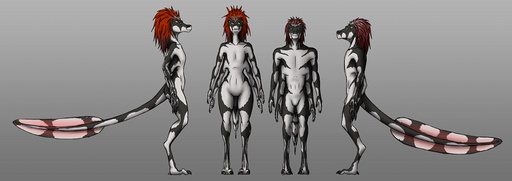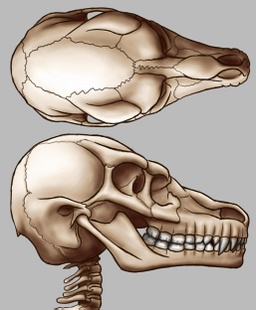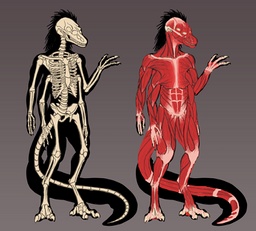Raharrs:Anatomy
Biology
Appearance
Upper extremities have three long flexible fingers, one of which is opposed to the others, and on the lower - three toes. Third toe gradually lost its mobility in the process of evolution and is now more a part of the heel than the functional part of the body, but can still move and helps in balancing.
The upper pair of arms is anatomically convergent to human arms, except that spaced farther from the body. It is necessary for the free space of the second pair of arms. The lower pair is not fixed to the skeleton and kept in place only by muscles and ligaments (kinda like in cats). Physically much weaker than the top arms, since they were used mainly only for grasping onto tree branches or resting the weight of the body upon them. Because of this, as well as anatomical structure, the lower pair of limbs still able to allow leaning onto, or hold lightweight items, but is not able of lifting a lot of weight, under the risk of damage to ligaments and muscles.
The torso is elongated and trapezoidal, rib cage is divided into two segments which can slightly slide relative to each other, diminishing the overall rigidity of the upper section of the body. The tail is equal in length to the rest of the body and has a fin that occupies one-third the length in females and two-thirds of the length in males. The tail is moveable relative to, the most in a horizontal plane, the flexibility gradually increases towards the tip of the tail. Tail assist with propulson in water, and helps balancing on land. The size of the fin in the society is one of the criteria of beauty.
Raharrs have "hair", similar in structure and function to terrestrial analogue, but their "hairs" look more like triangular stripes, reminiscent of grass leaves. Hair is pale and almost colorless at the base, but with the growth darkens and brightens in color. Hair concentrated on the head and upper neck, virtually non-existent in other parts of the body, in some cases, the growth area is enlarges down to the middle of the back.
The body has a two-tone color, white skin on the inner surfaces of the limbs and torso on the front side, the darker pigment distributed on the external parts of the body and spine. Pigmentation also forms stripes, the number of which can vary on the tail and face. Females painted lighter than males, and have less stripes on the tail.
On average raharr is 200-230 cm tall (~7.5 ft) and weighing 130-160 kg (~300 lbs). Females are usually taller than males.
Sexual dimorphism is expressed in a smaller distribution of body fat in males compared with females, and a wider hips in females, broader shoulders and a greater physical strength in males. In addition, males tend to have more elongated tail fin. Females also have softer claws and muzzle curving upwards.
Senses
Four eyes allows raharrs to have both binocular and monocular vision, but rear pair of eyes is slightly less developed, and oriented more on detecting the movement, rather than providing a sharp image. The pupils of both eyes vertically oval, iris can be in different shades of green, yellow or blue, a relatively rare mutation gives a dull red color.
Raharrs hearing is worse than human's, they main sensory input being vision, but that's more because of the almost flat, conical shape of the ear, rather than the sensitivity of the eardrum. Ears have a valve which closes the ear canal, to protect the eardrum from water or loud sounds. The sense of smell is more acute than human one, but not by much. Nostrils, like ears, have valve that can isolate the nostril from water. These valves mostly operate reflexively, but raharrs are able to close them and consciously.
Environment
Raharrs feel comfortable in the range from +20 to +40 degrees Celsius, and can withstand the air temperatures up to +65 degrees. They cope with freezing temperatures noticeably worse due to the fact that the Harr has virtually no polar regions and winters; at -15 degrees they could already experience frostbite and very quick death from hypothermia. Due to evolving in a solar system with a relatively active stars, fauna of Harr better tolerates radiation, and raharrs are no exception. Their skin is denser and blocks more radiation, their DNA is also considerably more resistant to ionizing radiation, although not immune to it completely. On average, raharrs can live in environment that have twice the radiation background and three times as strong ultraviolet radiation than earth levels without any side-effects.
Inteernal organs
Reproduction
Raharrs, like most of the known species, reproduces sexually and have males and females. Pregnancy lasts about 7 months and ends with the birth of one to two newborns. Large quantities are much less common. Newborns are able to move around right from birth (first crawling, then moving on all the limbs, smoothly turning into fully developed bipedal posture), but blind in the first year of life and undergo a prolonged phase of additional development and growth that lasts about 15 years, after which begins the puberty phase, during which growth slows down, finally stopping at 25 years. From birth to about the middle of the development period, children are extremely limited in the ability of digesting food (although they can eat some types of food right from birth), their parents feed them by chewing and softening food with saliva. With the development of civilization, an increasing prevalence of pre-prepared nourishing mixtures, almost universally considered the best, safer and more aesthetic version of feeding.
Diet
Raharrs are omnivorous and eat an extremely wide range of both plant and animal food, but the basis of their diet is meat, usually prepared in some way. Gastric hyperacidity, together with a separate specialized organ allows them to safely decompose biological poisons and venoms, as a consequence raharrs are very hard to get fatal intoxication. This is a consequence of the conditions of fauna and flora of Harr, where most of the species use poison or venom as a means of defense or offense. These mechanisms, however, do not work well against inorganic and synthetic toxic substances, either by not degrading them into safe components or degrading them into elements that are no less dangerous. This results in heavy poisoning of the organism, and their metabolism is not fast enough and not used to dealing with contamination, to quickly get the toxines out of the body, which makes impact on the health even worse. Raharrs do not have that immunity to poisons right from the start, and it develops only after maturing of the bowels, which are usually quite accurately correlates with the end of the period of the manual feeding pre-chewed food by parents.
| Leaving the Cradle | The Cliff World | ||||||
|---|---|---|---|---|---|---|
| Species |
|  | ||||
| Organizations | Alliance | Independent Worlds | Science Corporation | Politics | |||||
| Technologies | Hephrene | Interstellar Travel | Spaceships | |||||
| Places | Planet Harr (Nelnusarr star) | "Shining" Space station | "Dawn" class spaceships | Artifact X | |||||
| Characters | Gharr | Zane | Hekaht | Ahshu | Quantum | Nea | Dan | Mark | Val | ! Virus | |||||
| Events | ! Overall chronology | |||||
| Further reading: | Civilization development stages | Instruments | Ideas | | ||||||


